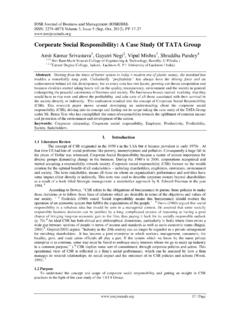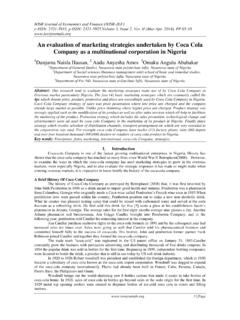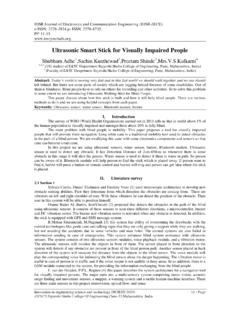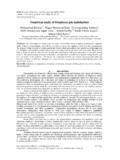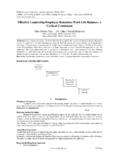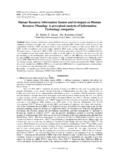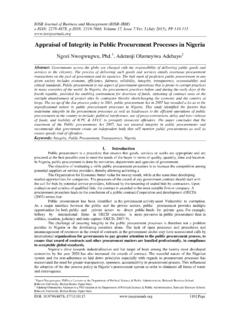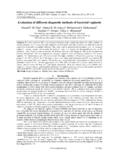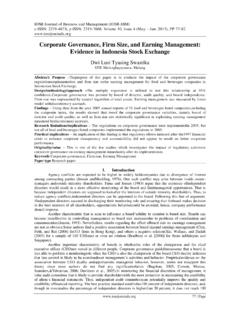Transcription of Problems and Challenges of Girl-Child Education in Nigeria ...
1 IOSR Journal of Research & Method in Education (IOSR-JRME) e-ISSN: 2320 7388,p-ISSN: 2320 737X Volume 4, Issue 4 Ver. IV (Jul-Aug. 2014), PP 01-05 1 | Page Problems and Challenges of Girl-Child Education in Nigeria : The Situation of Kalgo Local Government Area ( ) Of Kebbi State. Tyoakaa, Lazarus Mvendaga, Amaka, John Ifeanyichukwu And Nor, Apine Government Science & Technical College Bunza, Kebbi State- Nigeria . Abstract: The importance of Girl-Child Education cannot be over emphasized. Hence, this study therefore examined the Problems and Challenges of Girl-Child Education in kebbi state, with particular reference to Kalgo local government area.
2 The study adopted a descriptive survey research design. The population for the study comprised of all the fifty one (51) primary schools and four (4) secondary schools in Kalgo However, a sample of fourteen (14) primary and two (2) secondary schools was randomly drawn from each of the fourteen communities. Two research questions were formulated, while data collection was majorly through the use of archival data such, checklist/inventory and oral interviews, and analyzed using simple descriptive statistics and tables. The study revealed that, the Problems facing Girl-Child Education in Kebbi state is not far from poverty, early marriage, cultural and religious misconceptions.
3 The study recommends among other things that, government, non-governmental organizations, parents, traditional and religious leaders should join hands in the enlightment campaign for the benefits and need to educate a Girl-Child . I. Introduction The term Girl-Child refers to a female between the ages of 6-18 years (Mukhtar et al., 2011). The National Child Welfare Policy (1989) as cited by Ada (2001) defines the Girl-Child as a female below 14 years of age. Offorma (2009) defines it as a biological female offspring from birth to eighteen (18) years of age. This period is made up of infancy, childhood, early and late adolescence stages of development.
4 The Girl-Child is seen as a young female person who would eventually grow into a woman and marry. The gender apartheid places the Girl-Child in a disadvantaged position, where her potentials are suppressed and self-actualization is not achieved. She therefore, becomes a victim of a pre-existing socio-cultural male chauvinism. Furthermore, on the account of gender, girl-children are subjected to all multiple forms of oppression, exploitation and discrimination. Girl-Child Education has then become a major issue of concern in most developing countries of the world today, especially in sub-Saharan Africa, where a large number of young girls do not attend school .
5 According to UNICEF (2007), as cited by Grace (2010), the global figure for out-of- school children is estimated to be 121 million, out of which 65 million (approximately ) were girls and over 80 percent of these girls live in sub-Saharan Africa. primary school completion rates in Africa have been the lowest in the world and this remains a concern as half of the world s out-of- school children (OOSC) are concentrated in 15 countries, eight of which are in sub-Saharan Africa (Ibrahim, 2012). In sub-Saharan Africa, the number of girls out of school each year has risen from 20 million in 1990 to 24million in 2002 (Offorma, 2009).
6 Also, according to Goodluck (2011), Nigeria has 9 million (37%) out-of- school children, which is more than 0ne-third of its primary school age children and this is the highest in Africa. Nigeria grapples with increasing number of out-of- school children annually. This trend varies from zone to zone. For instance, in South Eastern Nigeria , which is dominated by the people of Igbo ethnic group, there is however low boy-child enrolment in school as compared to girls. This is because the boy-children are sent for apprenticeship in trading which is the dominant occupation of the people.
7 The opposite is the case in Northern Nigeria where there is low Girl-Child Education as compared to boys. Nigeria is among the West African countries that have the highest number of girls that are out of school , and more than 75% of the million children out of school are girls (UNICEF, 2007). The National school Census (NSC) (2006), also revealed a net enrolment ration of suggesting that a substantial proportion (19%) of primary school age population between 6-11years are not enrolled in primary schools nationwide, and this represents about 5million of Nigerian children of the age bracket of 6-11years old that do not have access to primary Education .
8 In the Northern part of Nigeria , which comprises three geo-political zones: the North East, North Central and North West. The north Central shows an improvement over others, these zones cannot boast of Problems and Challenges of Girl-Child Education in Nigeria : The Situation of Kalgo .. 2 | Page appreciable number of girls enrolment at primary and secondary schools level, not to talk of tertiary level of Education , as compared to boys enrolment. Statistics from the Federal office of statistics (2004) shows that, literate women constituted only 20% from the North -West, 20% North- East, and 45% from the North Central.
9 This indicates the levels of backwardness of women as compared to men in Northern Nigeria . The National school Census (2006) reported that the number of children out of school in Northern Nigeria is particularly high and the proportion of girls to boys in school ranges from 1 girl to 2 boys and even 1 girl to 3 boys in some states. The Education of girls in the northern cluster has always been a thorny and unresolved issue. Typically, Girl-Child Education in northern states follows a specific pattern which ends with the girls being denied from the system, the chances to attend primary school or further their Education beyond primary school .
10 Enejere (1991) avers that gender inequality especially in Northern Nigeria is promoted by religious and communal customs, which has grave consequences for both the individual and the society making her a dysfunctional member of the society. So many factors have been reported to be responsible for low enrolment of girls in schools in northern Nigeria . Mukhtar et al. (2011) identified religious misinterpretation, cultural practice, poverty, early marriage, illiteracy, inadequate school infrastructure as some of the factors militating against Girl-Child Education . To majority of the parents, Girl-Child Education is less important because no matter what level of Education the girl attains, their hope is to see the Girl-Child get married.
